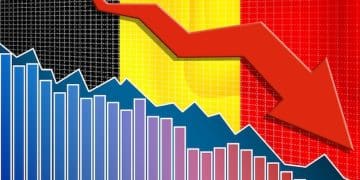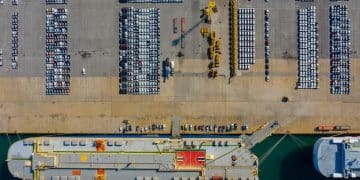US Dollar Strength in 2025: Expert Economic Insights

Navigating the Economic Landscape: Expert Insights on the US Dollar’s Strength in 2025 examines factors influencing the dollar’s potential trajectory, including economic indicators, geopolitical events, and monetary policies, providing an expert analysis of possible outcomes for businesses and investors.
The global economic landscape is constantly shifting, and understanding the potential trajectory of the US dollar is crucial for businesses, investors, and policymakers alike. This article provides expert insights on Navigating the Economic Landscape: Expert Insights on the US Dollar’s Strength in 2025, exploring the key factors that could influence its value and impact on the global economy.
Understanding the Foundations of US Dollar Strength
The strength of the US dollar is underpinned by a complex interplay of factors. This section will delve into the core elements that contribute to the dollar’s value and influence its standing in the global financial system.
Economic Indicators and Their Impact
Economic indicators provide critical insights into the health and performance of the US economy, directly influencing the dollar’s perceived strength. Understanding these indicators is essential for predicting future movements.
Key indicators include Gross Domestic Product (GDP) growth, inflation rates, employment figures, and consumer confidence indices. Strong economic performance typically boosts the dollar’s value, while weaker indicators can lead to depreciation.
The Role of Monetary Policy
The Federal Reserve (Fed), the central bank of the United States, plays a pivotal role in managing monetary policy. Its decisions on interest rates and quantitative easing directly impact the dollar’s appeal to investors.
- Interest Rate Hikes: Raising interest rates can attract foreign investment, increasing demand for the dollar.
- Quantitative Easing: Implementing or tapering quantitative easing programs can influence market liquidity and impact the dollar’s value.
- Forward Guidance: The Fed’s communication about future policy intentions can shape market expectations and influence the dollar’s trajectory.

In conclusion, the US dollar’s strength is built upon a foundation of robust economic indicators and strategic monetary policy decisions. Monitoring these factors is crucial for forecasting the dollar’s movement in the coming years.
Geopolitical Factors and Their Influence on the US Dollar
Beyond domestic economic factors, geopolitical events significantly impact the US dollar’s value. This section examines how global uncertainties and political developments can influence the dollar’s strength.
Global Political Stability
Periods of geopolitical instability often drive investors to seek safe-haven assets, and the US dollar frequently benefits from this flight to safety. Political tensions, conflicts, and uncertainties in other regions can increase demand for the dollar.
Conversely, increased global stability and cooperation can reduce the dollar’s safe-haven appeal, potentially leading to a decline in its value relative to other currencies.
Trade Wars and International Relations
Trade policies and international relations play a crucial role in shaping the landscape of the US dollar. Trade wars, tariffs, and diplomatic tensions can create volatility in currency markets.
- Trade Agreements: New trade agreements can positively impact the dollar by increasing US exports and economic activity.
- Tariffs and Sanctions: Imposing tariffs or sanctions can negatively affect the dollar by disrupting global trade flows.
- Geopolitical Alliances: Strong geopolitical alliances can enhance the dollar’s position as a reserve currency.
Geopolitical factors are a critical consideration in understanding the future of the US dollar. Monitoring these events and their potential impact is essential for making informed investment decisions.
Forecasting Economic Trends: Scenarios for 2025
Predicting the future performance of the US dollar requires carefully analyzing various economic trends and creating potential scenarios for 2025. This section outlines several plausible outcomes and their implications.
Scenario 1: Continued Economic Growth
In this scenario, the US economy maintains a steady growth rate, supported by strong consumer spending, business investment, and technological innovation. Inflation remains under control, allowing the Fed to maintain a stable monetary policy.
Under this scenario, the US dollar is likely to remain strong, attracting foreign investment and maintaining its position as a leading global currency.
Scenario 2: Economic Slowdown and Recession
This scenario involves a significant slowdown in economic activity, potentially leading to a recession. Factors such as high inflation, rising interest rates, and declining consumer confidence could contribute to this outcome.
In this recessionary environment, the US dollar may experience periods of weakness, though it could still retain some safe-haven appeal due to its relative stability compared to other currencies.
Scenario 3: Global Economic Recovery
In a global economic recovery, stimulated by coordinated fiscal and monetary policies, the need for the safety of the US dollar may reduce, leading to some dollar weakness.
As economies around the world improve, their individual currencies could gain strength, reducing the reliance on the dollar as the primary reserve currency.

Forecasting economic trends and considering these scenarios is crucial for understanding the potential future direction of the US dollar. Each scenario presents unique challenges and opportunities for investors and policymakers.
The Impact of Technological Innovation on the US Dollar
Technological advancements are reshaping industries and markets, and their impact on the US dollar cannot be ignored. This section explores how innovations in technology can influence the dollar’s strength and role in the global economy.
Digital Currencies and Blockchain Technology
The rise of digital currencies, including cryptocurrencies and central bank digital currencies (CBDCs), poses both challenges and opportunities for the US dollar. These new technologies could disrupt traditional financial systems and alter the demand for the dollar.
While cryptocurrencies may offer alternative means of payment and value storage, the US dollar could benefit from the development of a well-regulated CBDC that leverages blockchain technology to enhance efficiency and security.
Artificial Intelligence and Automation
Artificial intelligence (AI) and automation are driving productivity gains and transforming business operations across various sectors. These advancements could strengthen the US economy and, consequently, boost the dollar’s value.
- Increased Efficiency: AI-driven automation can improve efficiency in manufacturing, logistics, and services, leading to higher profits and economic growth.
- Data Analytics: AI-powered data analytics can provide valuable insights for businesses and policymakers, enabling better decision-making and resource allocation.
- Innovation: AI can accelerate innovation by automating research and development processes, fostering new products and services that drive economic growth.
Technological innovation is poised to have a significant impact on the US dollar. Embracing these advancements could strengthen the dollar’s position in the evolving global financial landscape.
Expert Opinions and Forecasts
To gain a comprehensive understanding of the US dollar’s potential strength in 2025, it is essential to consider the opinions and forecasts of leading economic experts. This section gathers insights from economists, analysts, and financial professionals to provide a well-rounded perspective.
Consensus Views From Leading Economists
Many economists believe that the US dollar will remain a dominant force in the global economy due to its reserve currency status, strong economic fundamentals, and the stability of the US political system. However, there are varying opinions on the extent of its strength.
Some experts predict that the dollar will continue to appreciate against other currencies, driven by rising interest rates and strong GDP growth. Others anticipate a more moderate trajectory, citing concerns about inflation and geopolitical risks.
Potential Risks and Challenges
Experts also highlight potential risks and challenges that could undermine the dollar’s strength. These include:
- Rising National Debt: A growing national debt could erode investor confidence in the US economy and weaken the dollar.
- Geopolitical Tensions: Escalating geopolitical tensions could trigger a flight to safety, but also disrupt global trade flows and negatively impact the dollar in the long term.
- Inflationary Pressures: Persistent inflationary pressures could force the Fed to raise interest rates aggressively, potentially leading to a recession and weakening the dollar.
Expert opinions and forecasts provide valuable insights into the potential future direction of the US dollar. By considering a range of perspectives and potential risks, investors and policymakers can make more informed decisions.
Strategies for Businesses and Investors
Navigating the economic landscape and preparing for potential shifts in the US dollar’s strength requires strategic planning for businesses and investors. This section outlines key strategies to mitigate risks and capitalize on opportunities.
Hedging Currency Risk
Businesses engaged in international trade can mitigate currency risk by using hedging strategies. These strategies involve using financial instruments, such as options and futures, to offset potential losses from exchange rate fluctuations.
Investors can also use currency hedging to protect their international investments from adverse currency movements. This can involve buying or selling currencies in the forward market or using currency options.
Diversifying Investments
Diversifying investments across different asset classes and geographic regions is a fundamental strategy for managing risk. By spreading investments across a range of assets, investors can reduce their exposure to any single currency or market.
Businesses can also diversify their supply chains and customer base to reduce their dependence on the US market and mitigate the impact of a weaker dollar.
Staying Informed and Adaptable
In today’s rapidly changing economic environment, staying informed and adaptable is crucial for success. Businesses and investors should continuously monitor economic indicators, geopolitical events, and expert forecasts to anticipate potential shifts in the US dollar’s strength.
Adaptability is key to navigating uncertainty. Businesses and investors should be prepared to adjust their strategies as needed to respond to evolving market conditions and capitalize on new opportunities.
| Key Point | Brief Description |
|---|---|
| 📈 Economic Indicators | GDP, inflation, & employment data influence dollar strength. |
| 🌍 Geopolitical Factors | Global stability & trade relations impact dollar’s safe-haven status. |
| 🤖 Technological Innovation | Digital currencies & AI influence the dollar’s role. |
| 🏦 Monetary Policy | The Federal Reserve’s actions affect investment attractiveness. |
Frequently Asked Questions
▼
The strength of the US dollar is influenced by economic indicators, geopolitical events, monetary policy decisions made by the Federal Reserve, and investor sentiment towards the US economy.
▼
Geopolitical tensions often lead investors to seek safe-haven assets like the US dollar, increasing its demand and value. Conversely, improved global stability can diminish its safe-haven appeal.
▼
The Federal Reserve influences the dollar’s strength through interest rate adjustments, quantitative easing policies, and forward guidance, which impact market expectations and investment decisions.
▼
Businesses can hedge against currency risk by using financial instruments such as options and futures to offset potential losses from exchange rate fluctuations, ensuring stability in international transactions.
▼
Potential risks include a rising national debt, escalating geopolitical tensions, inflationary pressures, and a significant economic slowdown or recession, all of which could erode investor confidence.
Conclusion
In conclusion, navigating the economic landscape to assess the US dollar’s strength in 2025 requires a comprehensive understanding of economic indicators, geopolitical factors, monetary policies, and technological innovations. By staying informed and adaptable, businesses and investors can develop effective strategies to mitigate risks and capitalize on opportunities in the evolving global economy.






